Ruth Ellen Gruber's Blog, page 3
October 21, 2014
Photo gallery: Beautiful but Desolate Kerepesi Jewish cemetery in Budapest
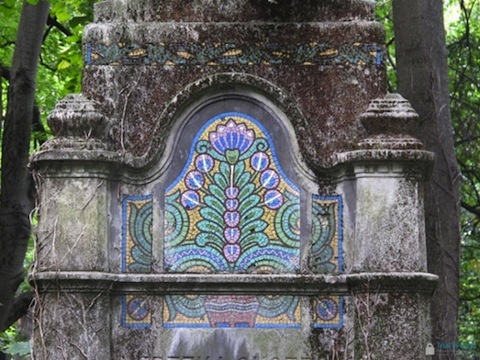
By Ruth Ellen Gruber
(This post also appears on my En Route blog for the LA Jewish Journal)
In Budapest earlier this month, I visited the Jewish cemetery on Salgotarjan street, which was founded in 1874 and is the oldest Jewish cemetery in the Pest side of Budapest.
It is actually the Jewish section of the city’s Kerepesi monumental cemetery, where national heroes are buried — and is the final resting place of many wealthy and influential Hungarian Jews of the time. Massive family tombs of Jewish noble families and industrialists line the perimeter; but there are also the graves of ordinary people. There is also a section where Holocaust victims are buried.
I had not been there in years -- despite some efforts at clean-up some time back, the cemetery is more densely overgrown than ever and tragically neglected, and I was glad that a friend came with me, as I do not like wandering around there by myself. There used to be a lot of stories of homeless people camping down there, or others coming in to rob the graves. Once I was startled to flush out a pheasant. There is decent security now, though, and a responsible young caretaker (who tied up his dogs when we arrived).
Still, many of the huge tombs of families who once wielded social, political and financial power are literally crumbling; collapsing and being swallowed by vines and other vegetation. Some of them have been broken open: you can even see the coffins in the crypts.
Quite a few of the tombs are the work of leading architects of the day — such as Ignác Alpár, Sándor Fellner, Albert Körössy, Emil Vidor and Béla Lajta. Lajta, whose work prefigured art deco, also designed the entry way from the street and the massive Ceremonial Hall (now roofless), built around 1908.
I posted a gallery of photos on www.jewish-heritage-europe.eu, the web site that I coordinate for the Rothschild Foundation Europe.
Here are just a few of them (all photos © Ruth Ellen Gruber) -- click here over to Jewish Heritage Europe to see the full selection .
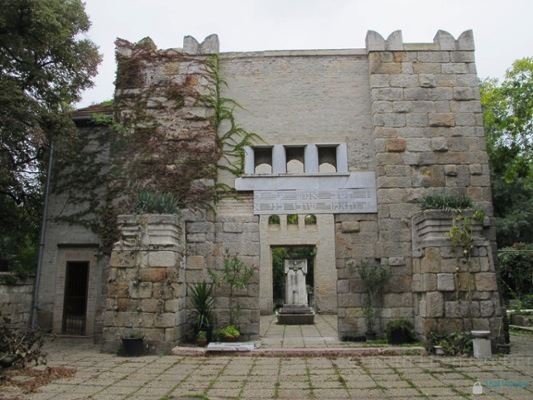
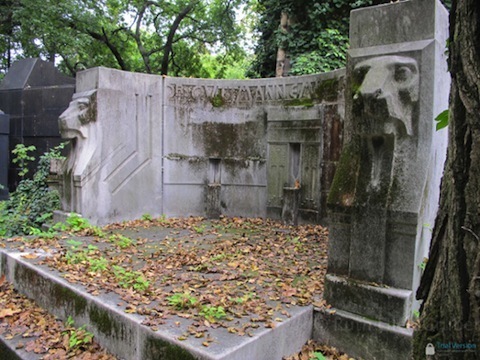
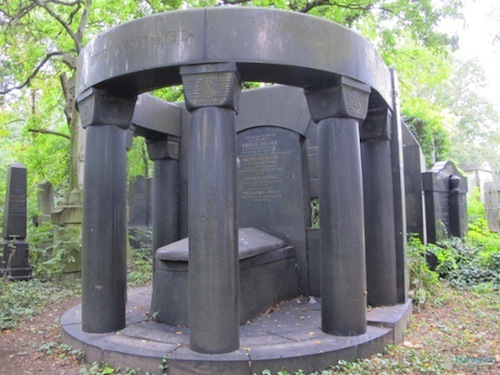
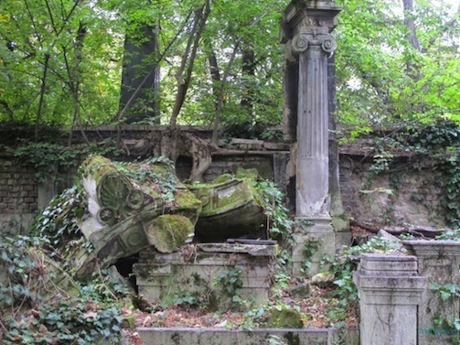
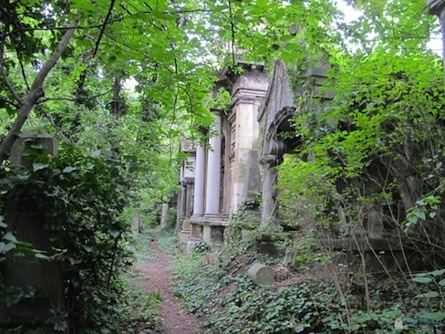
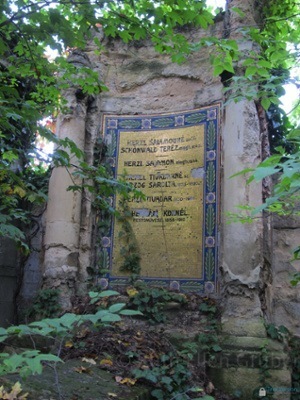
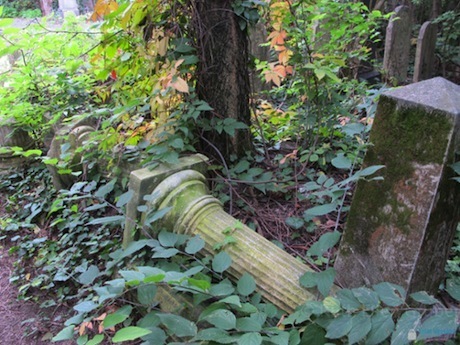
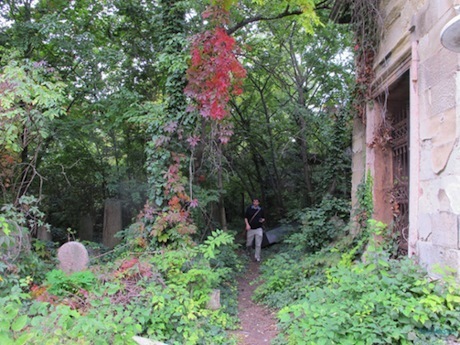
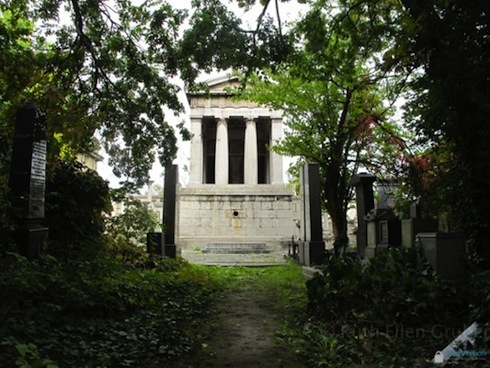
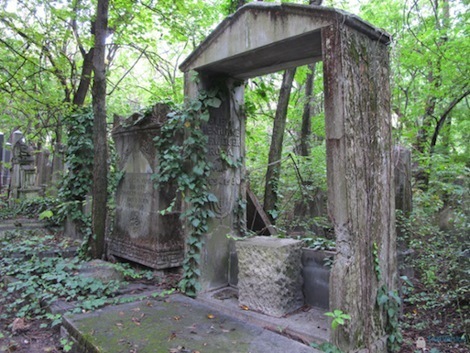
Click to see more pictures
Published on October 21, 2014 09:55
October 20, 2014
Jewish Heritage Europe October newsletter is online
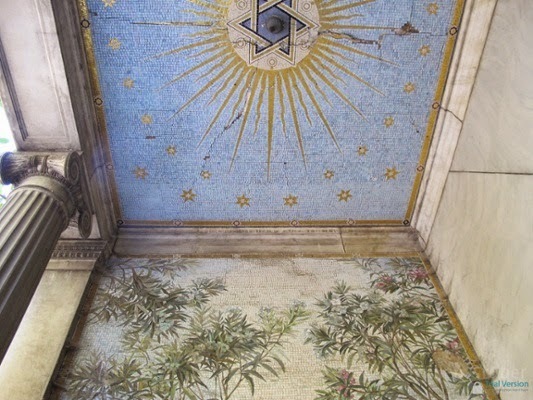 In a grand family tomb in the vast Kozma utca Jewish cemetery in Budapest
In a grand family tomb in the vast Kozma utca Jewish cemetery in BudapestThe Jewish Heritage Europe Newsletter for October went out last week….
This issue focuses on important completed synagogue restoration projects in several countries -- Spain, Czech Republic, Slovakia, Hungary, and Lithuania -- plus other news highlights from around the continent that have been featured in recent weeks on Jewish Heritage Europe, the web site that I coordinate as a project of the Rothschild Foundation Europe.
There is also a link to the JHE Photo Galleries, a growing collection of galleries where many new images have been posted...Take a look -- one of the new galleries celebrates Simchat Torah with a series of images of decorated Arks from synagogues around Europe.
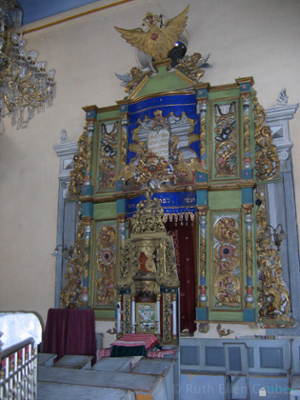 Ark in synagogue in Roman, Romania
Ark in synagogue in Roman, Romania You may submit your own photos to add to the galleries.
Click here to see the Newsletter in your browser -- better still, sign up for automatic monthly delivery that will link you to a fascinating selection of updates and images from all around Europe.
There's a lot going on -- synagogue restorations, clean-ups of Jewish cemeteries, exhibition openings, guided tours, Jewish culture festivals -- and more.
You can also receive more frequent news by subscribing to the almost-daily newsfeed (blog) using the box on the the JHE home page.
Thanks!
Published on October 20, 2014 13:38
September 28, 2014
Nearly 25 years later, revisiting the old question : Should old synagogues in Eastern Europe be restored?
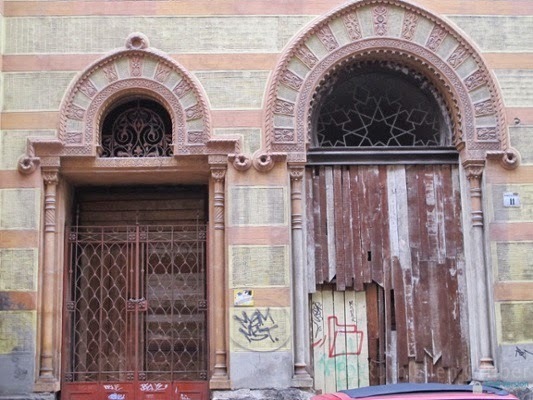 Exterior Rumbach st. synagogue, Budapest, December 2011. Photo © Ruth Ellen Gruber
Exterior Rumbach st. synagogue, Budapest, December 2011. Photo © Ruth Ellen GruberI'm crossposting this item that I put up today on Jewish Heritage Europe, the web site that I coordinate as a project of the Rothschild Foundation Europe. It looks back over the past quarter century of Jewish heritage preservation and priorities -- showing that despite progress that has been made and mind-sets that have changed, much still resonates:
Writing in September's Moment Magazine, Phyllis Myers posed the old question: should old synagogues in eastern Europe be saved?
Her answer — and mine — is, of course, a resounding YES.
It is important to remember, however, as Myers points out, that this answer was not self-evident — or even all that widely held — when she, and others involved in the field, first posed the question a quarter of a century ago, after the fall of the Iron Curtain.
Myers first did so in a long article, also in Moment, published in 1990, called “The Old Shuls of Eastern Europe: Are They Worth Saving?”
It’s worth reading again today to get a sense of the situation on the ground — and in people’s mind-sets — back then, just as the movement to document and restore Jewish built heritage in eastern and central Europe was getting under way. In a sense, her article represented a sort of blueprint for what could — and should — be the preservation priorities for the coming generation.
As more restoration takes place, the need for integrity and creativity in communicating the many dimensions of the Jewish experience will grow. The answer is not just a series of plaques on the buildings. Or more exhibit cases of Jewish ceremonial objects. Or lists of famous Jews. We must strive to evoke a unique encounter between visitor and place. We need to remember that as time passes a n d travel increases, visitors will want to know more about how Jews lived as well as how Jews died.
A quarter of a century later, the essence of what she wrote still holds true. The priorities she outlined are still priorities that should be addressed, and — despite the many successes and great strides accomplished — her message and the concepts she framed still have a powerful resonance. Indeed, one of the synagogues whose deteriorated condition she specifically mentioned in 1990 – the Rumbach st. synagogue in Budapest — still languishes in a sorry state despite sporadic efforts to restore it.
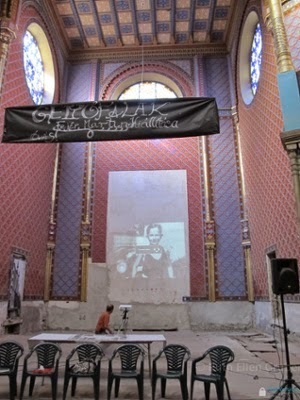 Interior of Rumbach st. synagogue, 2011
Interior of Rumbach st. synagogue, 2011“We preserve—buildings and places, the simple and the awesome—for many reasons,” Myers wrote in 1990.
We preserve to remember. For decades, Jewish preservation in Eastern Europe has focused primarily on places of death. Chasidim have tended cemeteries, especially the graves of Tzadikim (charismatic leaders), while other Jews have ensured that death camps remain as witnesses to a story that could otherwise become myth.
But preservation means Jewish life as well as death. When we walk in the footsteps of our forebears, contemplate their lives, stand in the places where they lived—and were betrayed—powerful linkages occur between their lives and ours.
We preserve to learn. American architectural historian Carole Herselle Krinsky writes, “Synagogues…reveal especially clearly the connections between architecture and society.” Clues to self-perceptions of Jews over the centuries, the evolution of faith and culture and relations with Gentile neighbors abound in the shapes, materials, designs and settings of synagogues. Did a community choose Gothic or Moorish ar chitecture, site its synagogue on the street or set it back off a courtyard, retain a separate entrance for women or build a gallery in the main hall? Did it raise a dome high or low in the community’s skyline, place the bimah (pulpit) in the center of the main hall or on the east wall? Did it hire a Jewish, Gentile or Viennese architect? Why did poor Jewish artists in old Poland decorate their synagogue walls with colorful, representational frescoes and pious prayers?
We preserve to provide settings for dialogue. It is true that in many places in Eastern Europe few, if any, Jews are left, and to talk about understanding, much less recon ciliation, would be glib. Yet a dialogue that goes beyond the “chamber of horrors” of the Shoah is clearly underway, fostered in special ways by sites embedded with memories. [...]
We preserve to transcend. On Simchat Torah, 1989, Cracow’s revered Remuh Synagogue, rebuilt but used continuously since the mid-1550s, reverberated as 40 Israeli teenagers took over the service from a forlorn group of elderly survivors and vibrantly danced and sang “Am Yisrael Chat”—the people of Israel live. The benefactor who paid for the Szeged synagogue’s restoration put it this way: “I just want to know that the synagogue I remember from my childhood is still there.” [...]
We preserve to fulfill our commit ment to life. For preservation to play this role—or any successful role—in Eastern Europe, sites need to be accessible, marked and interpreted in compelling ways. [...]
Click here to read Myers’s 1990 Moment article
Published on September 28, 2014 13:19
August 29, 2014
More than 40 Jewish Culture, etc, festivals each year in Poland!
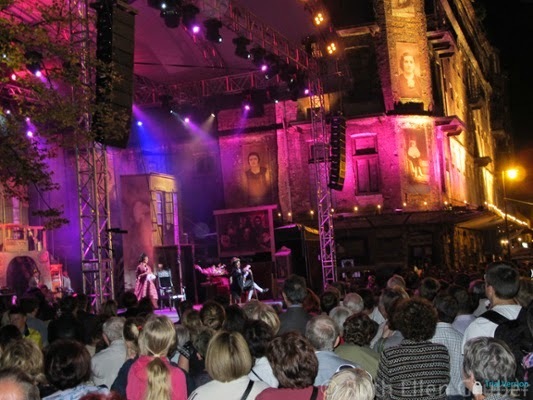 Singer's Warsaw Festival, 2011
Singer's Warsaw Festival, 2011By Ruth Ellen Gruber
Readers of this blog know that each year since 2009 I have tried to put together a list of Jewish culture, music, film -- etc -- festivals that take place around Europe.
This year (so far) the list includes 40 or so, in more than a dozen countries.
My list is far from totally comprehensive -- I know I miss quite a few events. But I believe it is still probably the most complete list of such festivals Europe-wide.
Still, my list's incomplete-ness is borne out by a list of Jewish culture and other festivals in Poland, researched and complied by Agnieszka Gis, a young volunteer at the Krakow Jewish Community Center who this summer is working as an intern at the Taube Foundation in San Francisco.
Agnieszka's list includes more than 40 festivals, of all sorts. That's 40 Jewish culture, film, music and other such festivals in Poland alone -- a country whose Jewish community today numbers probably some 15,000 or so!
There are big festivals, such as the Jewish Culture Festival in Krakow and the Singer's Warsaw festival in Warsaw. But many are in small towns and even far-flung villages. Most are organized by non-Jews and directed at a non-Jewish audience, perfect examples of what I have I described as the "virtually Jewish" phenomenon.
Click here to see Agnieszka's list in PDF form (you will have to enlarge it to read)
Published on August 29, 2014 07:41
August 19, 2014
The August Jewish Heritage Europe Newsletter is Out!
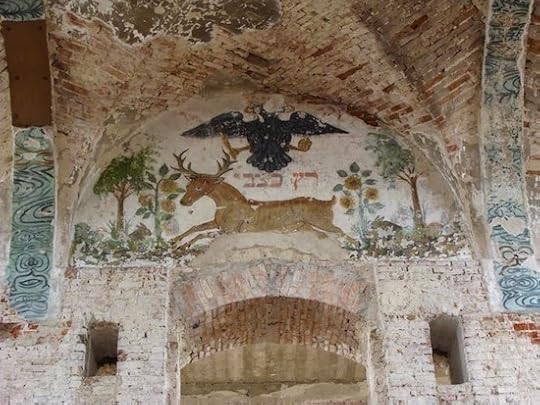 Synagogue in Orla, Poland. Photo: W. Wejman/Shtetl Routes
Synagogue in Orla, Poland. Photo: W. Wejman/Shtetl RoutesThe latest edition -- August -- of the Jewish Heritage Europe monthly Newsletter is out, and up online.
It features a selection of items that were posted on JHE's regular Newsfeed over the past month.
Top story is the series of "field notes" from the ambitious Shtetl Routes project, a Jewish heritage tourism project in Poland, Belarus and Ukraine that is under way with a more than $400,000 grant from the European Union.
Other stories range from the completed restoration of the synagogue in Tulcea, Romania to archaeology at Krakow's Old Synagogue.
Take a look!
It's easy to subscribe -- you'll get the Newsletter automatically in your email inbox.
Also subscribe to the regular Newsfeed for more frequent updates about what's happening in the Jewish heritage world.
Published on August 19, 2014 06:17
New tourism app for Jewish Basel, Switzerland
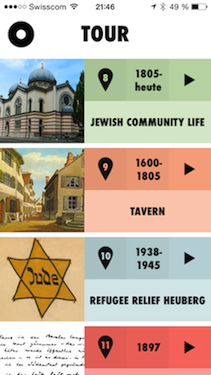
By Ruth Ellen Gruber This also appears on my En Route blog for the LA Jewish Journal Going to Basel, Switzerland and interested in Jewish life and heritage?Then you'll want to get a new app for smartphones and tablets that is officially being launched on August 26.Called "Baleph," the app is designed for both IOS and Android platforms and is in English and German.It leads the user on a "stroll through Basel's Jewish history" via a 13-stop, multimedia walking tour that highlights Jewish history in the city from the middle ages to the present. Featuring text, sound, and images, an Interactive timeline, and a city map with GPS function, it contains 65 minutes of audio material covering a tour lasting 1 ½ to 2 hours.Here are the links:iOS: https://itunes.apple.com/us/app/baleph/id895724718?mt=8&ign-mpt=uo%3D4Android: https://play.google.com/store/apps/details?id=ch.merianstiftung.baleph&hl=enWebsite: www.baleph.ch
Published on August 19, 2014 06:06
July 21, 2014
July Jewish Heritage Newsletter: Czech 10 Stars; Photo Galleries
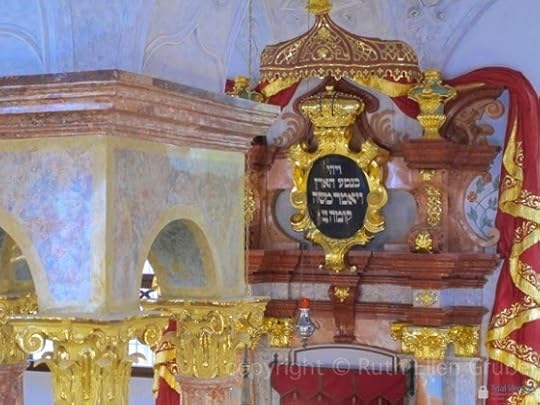 Bimah and reconstructed Ark in the synagogue in Mikulov. Photo © Ruth Ellen Gruber
Bimah and reconstructed Ark in the synagogue in Mikulov. Photo © Ruth Ellen GruberBy Ruth Ellen Gruber
Please take a look at the July edition of the monthly newsletter of Jewish Heritage Europe -- the website on Jewish heritage issues that I coordinate as a project of the Rothschild Foundation (Hanadiv) Europe.
Access it by clicking here -- and sign up for regular monthly delivery.
This issue has two main "cover stories," plus links to other news from Poland, France, Austria, Hungary and elsewhere.
One cover theme is the launch of new Photo Galleries on JHE -- galleries that readers are encouraged to contribute to.
The other is the inauguration in June of the wonderful Czech 10 Stars project, one of the most ambitious single Jewish heritage projects in Europe, linking 10 synagogues and associated Jewish heritage sites, in 10 towns all over the Czech Republic: in Úštěk, Jičín, and Brandýs nad Labem to the north; Plzeň and Březnice to the west; Nová Cerekev and Polná in the south-central part of the country; and Boskovice, Mikulov and Krnov to the east.
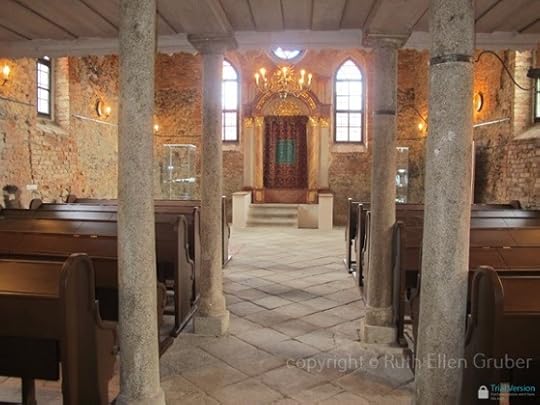 Synagogue interior, Polná. Photo © Ruth Ellen Gruber
Synagogue interior, Polná. Photo © Ruth Ellen GruberThey have all been renovated (or re-renovated) with a mono-thematic exhibit installed in each to form 10 regional centers of Jewish culture and education (and tourism) -- sort of a nationwide Jewish museum..... (See previous JHE posts on the progress of the 10 Stars project HERE and HERE and HERE.)
Carried out by the Federation of Jewish Communities in the Czech Republic, the 10 Stars was financed by an approximately €11 million grant from the EU, with further funding from the Czech Culture Ministry.
I traveled hundreds of kilometers over the past few weeks to visit seven of these sites -- and have posted galleries of pictures from most of them.
10 Stars web site
Published on July 21, 2014 07:48
June 17, 2014
Jewish Heritage Europe launches monthly Newsletter
 Door to the orthodox synagogue in Presov, Slovakia
Door to the orthodox synagogue in Presov, SlovakiaBy Ruth Ellen Gruber
Jewish Heritage Europe -- the web site that I coordinate -- has just launched a monthly newsletter! The first edition came this week and contains a description of the web site's features as well as highlights from our regular almost-daily news feed.
JHE is an expanding web portal to news, information and resources concerning Jewish monuments and heritage sites all over Europe. A project of the Rothschild Foundation (Hanadiv) Europe, we foster communication and information exchange regarding projects, initiatives and other developments: restoration, funding, projects, best-practices, advisory services and more.
Our newsfeed is updated almost daily, and by now, with well over 500 posts, it represents a major searchable database of information on the contemporary status of Jewish built heritage in Europe.
Please take a look -- and subscribe and share!
Click here to see the Newsletter
Published on June 17, 2014 09:45
June 14, 2014
Balagan Cafe in Florence is Back for the Summer

by Ruth Ellen Gruber
Going to Florence this summer? Well, Balagan Cafe is back -- the weekly open house/garden party on the tree-shaded grounds of the city's magnificent synagogue.
Just about every Thursday evening through August, the Jewish community invites the public for what they call an "apericena" -- a combination aperitivo drink and cena, or dinner -- with kosher food, wine and fancy cocktails.
In addition to the edibles and libations, each night programs concerts, talks, performances or other events, not to mention stands selling books, CDs and souvenirs.
Click here to see the full program.
The first edition of the Cafe was a big hit last summer -- with hundreds of people attending each week. They included members of the Jewish community but also many members of the mainstream public.
As I wrote last November in an article for The Forward:
Each Café featured music, lectures, discussions, performances and other events. There were free guided tours of the synagogue and stands selling books, CDs, Judaica and Balagan Café T-shirts depicting a full moon over the synagogue dome. Performers and featured participants included nationally known figures such as the rock singer Raiz, the Tzadik label klezmer jazz clarinetist Gabriele Coen, and the architect Massimiliano Fuksas, who designed, among other things, the Peres Peace House in Israel.
Meanwhile, food stands sold kosher meals and kosher wine to crowds eager to sample couscous, baked eggplant, beans with cumin and harissa, spicy chickpeas, Roman-style sweet and sour zucchini and other specialties. One evening saw a “competition” between Sephardic and Ashkenazic cooking; another featured a lesson in challah-making.
[...]
About 300 people turned up for the first Café in early June — most of them Jewish community members and their friends. But each week the numbers grew, thanks to enthusiastic local media coverage as well as word of mouth.
“It conquered the city,” journalist Fulvio Paloscia wrote in La Repubblica. By the summer’s last Café, on Aug. 29 — where I was featured in a public conversation ... about Jewish culture and mainstream society — the event drew 800 people. Crowds milled about the garden and listened to two concerts, one by a klezmer band and one by Sephardic singer Evelina Meghnagi. They also mobbed the food stand, where some 450 kosher meals were sold.
Published on June 14, 2014 13:01
May 27, 2014
Thousands visit Rome Jewish Museum, show Solidarity to Brussels
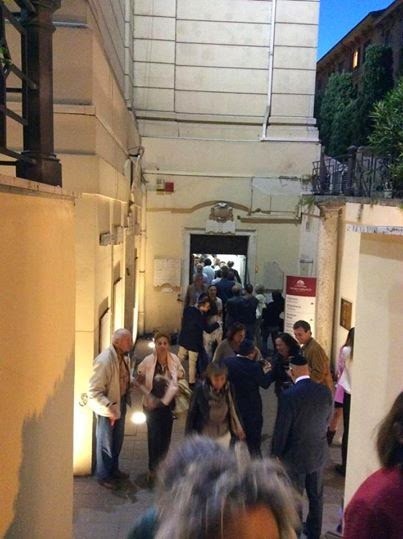 Visitors to Rome Jewish Museum Monday night. Photo: Shalom7
Visitors to Rome Jewish Museum Monday night. Photo: Shalom7By Ruth Ellen Gruber
This post also appears on my En Route blog for the LA Jewish Journal
Thousands of people lined up to visit the Rome Jewish Museum, which was specially opened for free Monday night to show solidarity with the Jewish Museum in Brussels and honor the victims of Saturday's shooting attack, which left four dead.
Other Jewish institutions in Italy also opened Monday night -- including the Shoah Memorial in Milan.
“This is our response to the attack, a ‘white night’ against fear,” Rome Jewish community president Riccardo Pacifici told the Italian media.
In Rome, Jewish leaders and political figures including the presidents of the Lazio and Puglia regions addressed the crowd before they entered the museum. The ambassadors of Belgium and Israel also were in attendance at an opening ceremony broadcast live on Italian TV.
"The Brussels assassins wanted to strike in the heart of culture, in a place where one wants to learn," Pacifici said. "They wanted to intimidate the Jewish community and the general public. Tonight the museum opens its doors to whoever desires to get to know it."
"There is no choice more just than to find ourself in a place of culture in order to respond to hatred and ignorance," Nicola Zingaretti, president of Lazio region, said. "The act of us all being here sends out the message that whoever carries out an act of ignorance will always have the eyes of the world upon them."
Dario Disegni, the president of the Italian Jewish Cultural Heritage Foundation, issued a statement Monday urging the more than a dozen other Jewish museums in Italy to also open to the public for free one day this week. “We feel confident that civil society in our country will want to feel the moral imperative to bear witness, through solidarity with the victims of the crime, to a firm commitment to safeguarding democracy and to the construction of a future of peace, justice and liberty,” he said.
The Association of European Jewish Museums issued a statement about the Brussels attack:
A murderous attack has taken four lives in the Jewish Museum of Belgium in Brussels on Saturday 24 May. The AEJM is deeply shocked by this atrocity directed against an institution that for many years stands for mutual understanding, tolerance and intercultural exchange - a symbol for the only possible future of Europe. We lack the words to describe our feelings of horror and we humbly want to express our solidarity with our friends. Hopefully the murderer will be identified and caught soon and it will be possible to shed light on this crime. We mourn with our colleagues of the Jewish Museum in Brussels and the families of those who lost their loved ones in this attack.
Published on May 27, 2014 02:50



